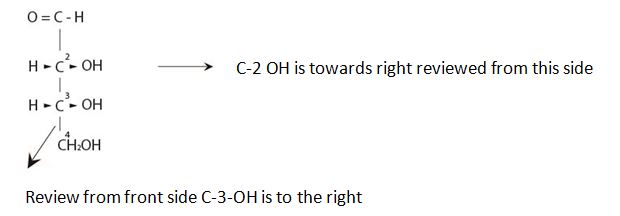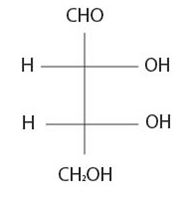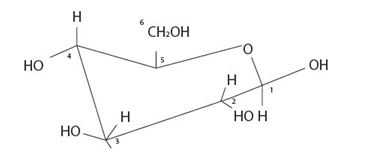
Concept explainers
a)
Interpretation:
The configurational stereochemistry of the molecules to be determined.
Answer to Problem 26VC
The Fischer projection follows as

It is D sugar the molecule is a retrose. Elclose or eldotetrose, is 4-carbon elclose.
Explanation of Solution
Concept strategy: The Fischer projection of the given monosaccharide is drawn vertically, by rotating the molecule anticlockwise 90° so that the carbonyl

Review from front side C-3-OH is to the right By convention the molecule has the C-3 hyduxyl at the right. So it is D sugar the molecule is a retrose. Elclose or eldotetrose, is 4-carbon elclose.
Based on the Fischer projection formula for the given sugars it is a B-D-glucopyranose monosaccharide.
b)
Interpretation:
The configurational stereochemistry of the molecules to be determined.
Answer to Problem 26VC
The given model is the cyclic structures of an aldohexose in six membered pyranose form.
Strategy: We redraw the model as

Explanation of Solution
By convention, the terminal -CH2OH group is on the top of the chair Pyranose structure. Thus it is a D sugar. The molecule is an aldohexose is B-D-glucopyranose, all the –OH groups are equatorial (and more stable due to minimum repulsion) conformation.
Based on the Fischer projection formula for the given sugars it is a B-D-glucopyranose monosaccharide.
Want to see more full solutions like this?
Chapter 25 Solutions
EBK ORGANIC CHEMISTRY
- What are the major products of the following reaction? Please provide a detailed explanation and a drawing to show how the reaction proceeds.arrow_forwardWhat are the major products of the following enolate alkylation reaction? Please include a detailed explanation as well as a drawing as to how the reaction proceeds.arrow_forwardA block of zinc has an initial temperature of 94.2 degrees celcius and is immererd in 105 g of water at 21.90 degrees celcius. At thermal equilibrium, the final temperature is 25.20 degrees celcius. What is the mass of the zinc block? Cs(Zn) = 0.390 J/gxdegrees celcius Cs(H2O) = 4.18 J/gx degrees celcusarrow_forward
- Potential Energy (kJ) 1. Consider these three reactions as the elementary steps in the mechanism for a chemical reaction. AH = -950 kJ AH = 575 kJ (i) Cl₂ (g) + Pt (s) 2C1 (g) + Pt (s) Ea = 1550 kJ (ii) Cl (g)+ CO (g) + Pt (s) → CICO (g) + Pt (s) (iii) Cl (g) + CICO (g) → Cl₂CO (g) Ea = 2240 kJ Ea = 2350 kJ AH = -825 kJ 2600 2400 2200 2000 1800 1600 1400 1200 1000 a. Draw the potential energy diagram for the reaction. Label the data points for clarity. The potential energy of the reactants is 600 kJ 800 600 400 200 0 -200- -400 -600- -800- Reaction Progressarrow_forwardCan u help me figure out the reaction mechanisms for these, idk where to even startarrow_forwardHi, I need your help with the drawing, please. I have attached the question along with my lab instructions. Please use the reaction from the lab only, as we are not allowed to use outside sources. Thank you!arrow_forward
- Hi, I need your help i dont know which one to draw please. I’ve attached the question along with my lab instructions. Please use the reaction from the lab only, as we are not allowed to use outside sources. Thank you!arrow_forward5. Write the formation reaction of the following complex compounds from the following reactants: 6. AgNO₃ + K₂CrO₂ + NH₄OH → 7. HgNO₃ + excess KI → 8. Al(NO₃)₃ + excess NaOH →arrow_forwardIndicate whether the product formed in the reaction exhibits tautomerism. If so, draw the structure of the tautomers. CO₂C2H5 + CH3-NH-NH,arrow_forward
- Draw the major product of this reaction N-(cyclohex-1-en-1-yl)-1-(pyrrolidino) reacts with CH2=CHCHO, heat, H3O+arrow_forwardDraw the starting material that would be needed to make this product through an intramolecular Dieckmann reactionarrow_forwardDraw the major product of this reaction. Nitropropane reacts + pent-3-en-2-one reacts with NaOCH2CH3, CH3CHOHarrow_forward
